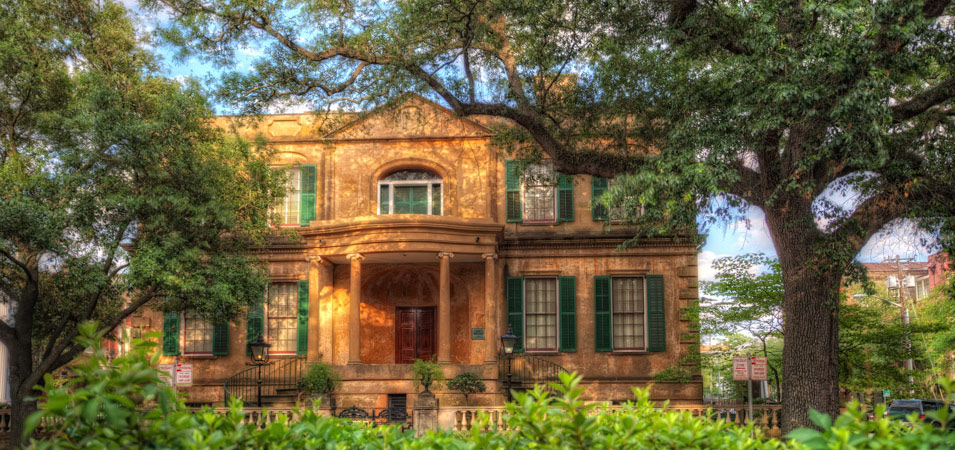Built in 1742, Oglethorpe Square was aptly named for Savannah’s founder, General James Oglethorpe. Once known as “Upper New Square,” Oglethorpe Square was among one of two squares established after James’ return from England, and the final of six squares initiated during James’ time in Georgia. Oglethorpe Square is located on Abercorn Street, between State and York Streets. Today Oglethorpe Square is known for its understated elegance. There are no monuments within Oglethorpe Square, making it an unusual Square for Savannah’s Historic District. Visitors to Oglethorpe Square may find the Owens-Thomas House, the Moravian Pedestal, and the Presidents’ Quarters Inn.
Oglethorpe Square has been linguistically renovated since 1742. Street names, for example, were renamed after the Revolutionary War. Imperial monikers were adapted to reflect colonial emancipation, with King Street becoming President Street, and Prince Street becoming State Street. Although Lincoln Street is commonly and falsely attributed to Abraham Lincoln, Lincoln Street was named for General Benjamin Lincoln, an American officer of the Continental Army. General Lincoln was unsuccessfully involved in the Siege of Savannah and remains a local hero.
The house of John Reynolds, Georgia’s first Governor, once occupied Oglethorpe’s southeast trust lot. Reynolds established the home in 1752 to overlook Oglethorpe Square, then known as the Upper New Square. The residence no longer remains, however. The trust lot is now a parking center for the Presidents’ Quarters Inn.
The Royal Surveyors of Georgia and South Carolina once resided in Oglethorpe’s northeast trust lot. Henry Yonge and William Gerard DeBrahm were among the first appointed. Yonge and Debrahm, commissioned at an annual salary of £50, were charged with administering grants and public land surveys. Yonge and DeBrahm encountered issues, however, whenever they recognized that Georgia could not subsist on small farms like England. The English climate provided better opportunities for crops, allowing for annual production. Although the Royal Surveyors would lay the foundation for the state’s settlement, Georgia’s Royal Surveyors bore a difficult beginning. Today Oglethorpe’s northeast trust lot is occupied by the Owens-Thomas House.
Oglethorpe’s 127-131 Lincoln Street is archetypal of Greek Revival style. This emblematic structure was owned and commissioned by Georgia railroad founder W.W. Gordon and George Anderson. The house, built by John Scudder in 1855, was later inhabited by General Alexander Lawton, the Confederacy's second Quartermaster-General. Lawton lived in the house’s East York Street facade alongside his wife in the 1870s. Yet the house is most renowned for Robert E. Lee’s nineteenth-century stay: Lee visited General Alexander Lawton in the house during his final visit to Savannah. Greek Revival architecture may also be found on Oglethorpe’s York Street. Built 1855, 205 East York was, notably enough, saved by the Historic Savannah Foundation in the mid-twentieth century.
Oglethorpe Square features a marker commemorating the Moravian missionaries of 1735. The Moravians were early yet brief settlers of Savannah who lent their support to John Wesley. The Moravians arrived at Savannah in 1735 yet relocated to Pennsylvania in 1740. The granite pedestal, erected in 1933, memorializes their contributions to Savannah. The Moravians created a mission among the region’s indigenous peoples. They likewise established a school for Savannah’s enslaved orphans. The pedestal is located in Oglethorpe’s northeastern corner, one block from the Moravian’s early mission site.
A plaque to General James Jackson can be located at the intersection of Abercorn Street and East State Street. The plaque, established in 1949 by the Savannah Chapter of the Daughters of the American Revolution, marks the site of Jacksons’ home. The plaque likewise commemorates General James Jackson as a revolutionary hero, statesman, and Governor of Georgia. General James Jackson is best known for his contributions to the Revolutionary War, where he served in the First Brigade Georgia Militia. General James Jackson is the namesake for Georgia’s Jackson County, James Jackson Parkway Northwest, Fort James Jackson, and the cities of Jackson and Jacksonboro.

The Owens-Thomas House rests at 124 Abercorn Street in the northeast quadrant of Oglethorpe Square. Built 1819, the Owens-Thomas House is the most historically and stylistically significant structure of the Square. Greek columns are joined by Roman arches, transitioning the House between Georgian and Classical Revival architectures. As one of the few remaining Regency Style houses designed by William Jay, the Owens-Thomas House is the most valuable example of Savannah’s preservation movement. Today the Owens-Thomas House is a National Historic Landmark and a historic house museum. The museum features a decorative art collection once owned by the Owens, as well as American and European objects from the eighteenth and nineteenth centuries.

The Presidents’ Quarters Inn is a historic bed and breakfast located at 225 East President Street. The Presidents’ Quarters Inn was established in 1855 by a pair of cotton merchants and comprises two nineteenth-century homes constructed in the Federal style. Notable guests to the Presidents’ Quarters Inn include Robert E. Lee, who was received in the inn by General Andrew Lawton. The inn’s sixteen rooms are each named after a United States President who has visited the city.
If you’re looking for a moment to relax, visit Oglethorpe Square. Visitors will find themselves soothed by the Square’s vegetation and quaint design. Guests often remark upon the charm of the park, enjoying its simplicity and stillness. Overarching oaks provide peace to the Square, shading visitors to Savannah’s celebrated Historic District. We hope you enjoy your sojourn.
Gallivanter offers the widest variety of highly-rated tours in Savannah. Make sure to book one for your trip to Savannah!
Our Savannah Tours